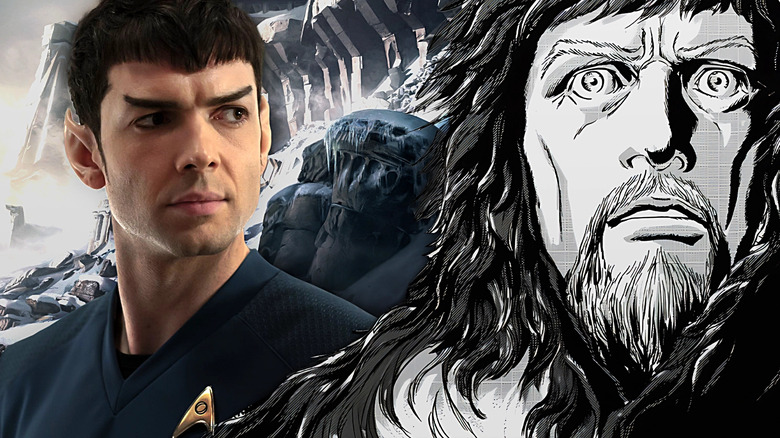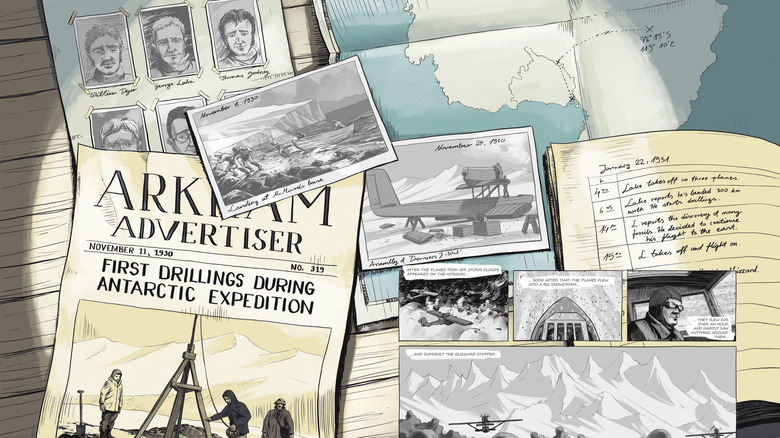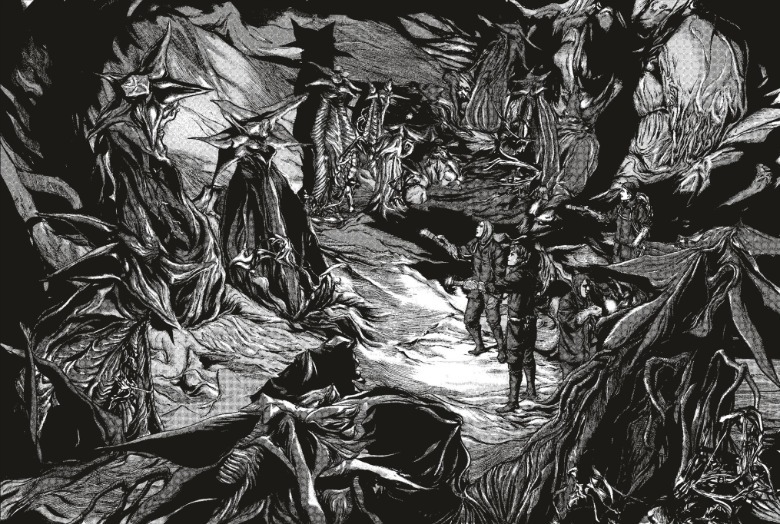Strange New Worlds Season 3 Episode 5 Reminds Us Of A Legendary Horror Story
We may receive a commission on purchases made from links.
Spoilers for "Star Trek: Strange New Worlds" to follow.
The main characters of "Star Trek" are explorers above all else, and sometimes, exploration is about investigating the past. That's exactly what happens in "Strange New Worlds" season 3, episode 5, "Through the Lens of Time."
In an earlier season 3 episode, "Wedding Bell Blues," we met Christine Chapel's (Jess Bush) new boyfriend Dr. Roger Korby (Cillian O'Sullivan). We know from "Star Trek: The Original Series" — specifically the episode "What Are Little Girls Made Of?" — that Chapel and Korby will get engaged, but it'll fall through when he goes missing on an archaeological dig.
"Through the Lens of Time" shows Korby in action as an archaeologist. He and a small away team, including Spock (Ethan Peck), La'an (Christina Chong), Uhura (Celia Rose Gooding), and Beto Ortegas (Mynor Luken), discover what appears to be an ancient temple from an extinct civilization. When they're locked inside, they learn that the normal rules of spacetime don't apply there.
The black metallic appearance of the temple, and the very premise of astronauts exploring a deserted city with dark secrets, evokes Ridley Scott's "Prometheus." But "Prometheus" and, in turn, "Through the Lens of Time" also pull from an older science-fiction story: H.P. Lovecraft's "At the Mountains of Madness."
In fact, filmmaker Guillermo del Toro gave up on a "Mountains of Madness" movie adaptation in the 2010s because "Prometheus" was soon to hit theaters. (Though del Toro later shared some computer-animated test footage from "At the Mountains of Madness" online, that's a far cry from the full picture.)
Published in 1936, "At the Mountains of Madness" follows a university team of scientists on an expedition to Antarctica. There, they discover evidence of a prehistoric civilization before several of the researchers are brutally murdered. The story's narrator, Dr. William Dyer, and his graduate student Danforth then uncover and explore an ancient city hidden behind imposing mountains. Billions of years ago, this city was home to alien "Elder Things." The Elder Things' downfall was their own creations: artificially-created shapeshifting servants known as shoggoths, which rose up to destroy their masters. Some of the shoggoths still live and they're what destroyed the camp. In the end, Dyer and Danforth barely escape the mountains with their lives, but Danforth does not retain his sanity.
(And yes, considering Lovecraft's infamous racism, the subtext of the shoggoths as revolting slaves destroying civilization and devolving into feral predators without their masters to mind them is as horrific as the creatures themselves.)
"At the Mountains of Madness" was one of Lovecraft's last stories, and it remains among his most influential. The original Dr. Korby "Star Trek" episode is even a pseudo adaptation of it.
A Star Trek that ends At the Mountains of Madness
In "What Are Little Girls Made Of?", Dr. Korby (Michael Strong) is found on the planet Exo III, where he has discovered the remains of an extinct civilization. This species, called the Old Ones because their true name is lost to time, had discovered how to create androids that could perfectly replicate the appearance and memories of living beings. Korby is even served by two androids: Ruk (Ted Cassidy), an android from the time of the Old Ones, and his own gynoid creation Andrea (Sherry Jackson).
Korby thinks that the androids are a better race, especially because they're immortal. "Through the Lens of Time" retroactively builds up to Korby's obsession with immortality by scientific means; it's a topic of his research papers and his latest dig. Could the ancient civilization in this episode be tied to the Old Ones from Exo III? Will Korby's discoveries in this episode push him onto the path we know he will eventually take? We'll have to keep watching to find out.
"What Are Little Girls Made Of?" is hardly cosmic horror, but the backstory of the Exo III civilization is ripped straight from "At the Mountains of Madness." Ruk recalls to Captain Kirk (William Shatner) how his creators fell: The Old Ones' androids became so advanced that they developed emotion and self-awareness and began to rebel. When the Old Ones tried to deactivate their creations, the conflict escalated into a war that destroyed both sides. Basically, the Old Ones are the Elder Things, and the androids are the shoggoths. However, since "Star Trek" barely had the budget to put alien actors in face paint, the androids aren't utterly alien-looking like the Elder Things and shoggoths. Ted Cassidy was super-tall (6' 9”), but even as Ruk, he's quite human looking.
The enduring influence of H.P. Lovecraft's Mountains of Madness
The root of this Lovecraft influence is the episode's scriptwriter: Robert Bloch (the author of "Psycho"), who was a protégé of Lovecraft and one of the preeminent writers in the Cthulhu mythos. Allan Asherman wrote about Bloch importing Lovecraftian storytelling to "Star Trek" in his 1981 book, "The Star Trek Compendium." As he put it:
"Bloch has Ruk speak of his creators as the Old Ones, and even the pyramid-shaped doors in the caverns conform to Lovecraft's descriptions of these ancient beings. 'Forbidden Planet's' underground complexes also featured such doors, as well as references to the Old Ones."
Yes, "Star Trek" is far from the only genre fiction that has looked to "At the Mountains of Madness" for influence. John Carpenter's "The Thing" adapts Lovecraft as much as John W. Campbell's "Who Goes There?" Similarly, the Batman comic/film "The Doom That Came to Gotham," a giant Lovecraft homage, begins with Bruce Wayne on an Antarctic expedition like William Dyer was.
While a proper "At the Mountains of Madness" film adaptation remains only a dream, several comic artists have adapted the story, attempting to translate the unknowable horrors Lovecraft described into concrete images. The best of those is Gou Tanabe's "At the Mountains of Madness" manga, which has photorealistic detail and makes both the violence and alien creatures all the more frightening with ghostly black-and-white coloring.
When blending science-fiction with horror, there are worse influences you can look to (warts and all) than H.P. Lovecraft, and "Star Trek" knows it.
"Star Trek: Strange New Worlds" is streaming on Paramount+, with new episodes available on Thursdays.



